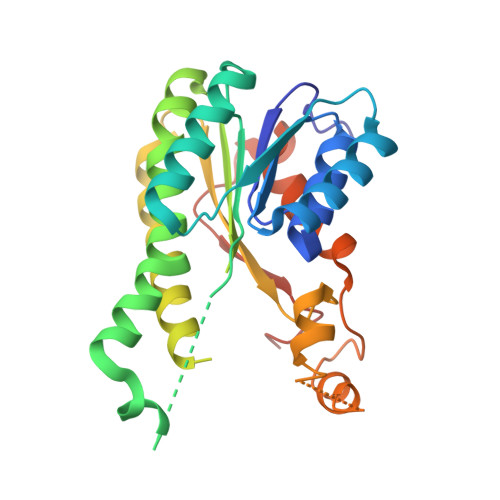Structural and functional investigation of AerF, a NADPH-dependent alkenal double bond reductase participating in the biosynthesis of Choi moiety of aeruginosin
Qiu, X., Wei, Y., Zhu, W., Fu, J., Duan, X., Jin, H., Zhu, P., Zhou, C., Yan, X.(2019) J Struct Biol
- PubMed: 31726097
- DOI: https://doi.org/10.1016/j.jsb.2019.107415
- Primary Citation of Related Structures:
6JH7, 6JHA, 6JHB - PubMed Abstract:
The 2-carboxy-6-hydroxyoctahydroindole (Choi) moiety is an essential residue for the antithrombotic activities of aeruginosins, which are a class of cyanobacterial derived bioactive linear tetrapeptides. Biosynthetic pathway of Choi is still elusive. AerF was suggested to be involved in the biosynthesis of Choi, and can be assigned to the short-chain dehydrogenase/reductase (SDR) superfamily. However, both the exact role and the catalytic mechanism of AerF have not been elucidated. In this study, functional and mechanistic analyses of AerF from Microcystis aeruginosa were performed. Observation of enzymatic assay demonstrates that AerF is a NADPH-dependent alkenal double bond reductase that catalyzes the reduction of dihydro-4-hydroxyphenylpyruvate (H 2 HPP) to generate tetrahydro-4-hydroxyphenylpyruvate (H 4 HPP), which is the third step of the biosynthetic pathway from prephenate to Choi. Comparative structural analysis indicates that ligand binding-induced conformational change of AerF is different from that of the other SDR superfamily reductase using H 2 HPP as a substrate. Analyses of NADPH and substrate analogue binding sites combined with the results of mutagenesis analyses suggest that a particular serine residue mainly involves in the initiation of the proton transfer between the substrate and the residues of AerF, which is an uncommon feature in SDR superfamily reductase. Furthermore, based on the observations of structural and mutagenesis analyses, the catalytic mechanism of AerF is proposed and a proton transfer pathway in AerF is deduced.
- Ministry of Education Key Laboratory of Applied Marine Biotechnology, Ningbo University, Ningbo, Zhejiang Province 315800, China; Institute of Marine Biotechnology, College of Food and Pharmaceutical Sciences, Ningbo University, Ningbo, Zhejiang Province 315800, China; Li Dak Sum Yip Yio Chin Kenneth Li Marine Biopharmaceutical Research Center, Ningbo University, Ningbo, Zhejiang Province 315800, China.
Organizational Affiliation:


















